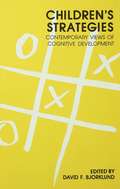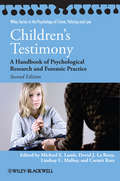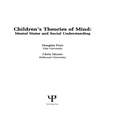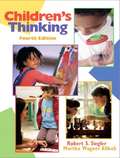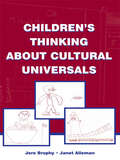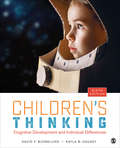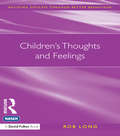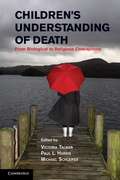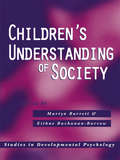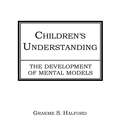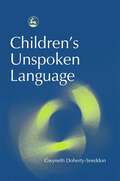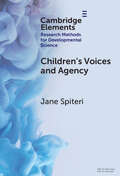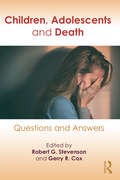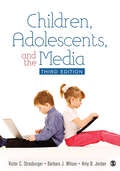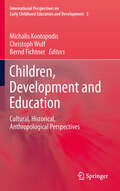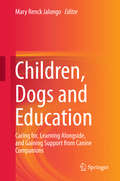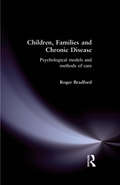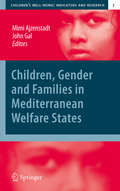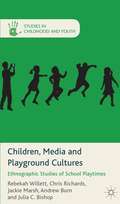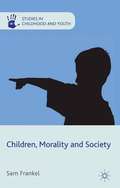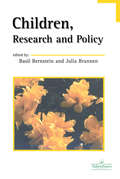- Table View
- List View
Children's Strategies: Contemporary Views of Cognitive Development
by David F. BjorklundOne of the issues central to both classic and contemporary theories of cognitive development is children's goal-directed behavior, which is typically investigated in terms of strategies. This book brings together in one volume the latest research and theory regarding the development of children's strategies for a variety of cognitive tasks.Opening with a history of strategy development research and concluding with a chapter that integrates the diversity of ideas expressed by the contributors, Children's Strategies offers intervening chapters that examine strategy development for attention, analogical reasoning, mathematics, memory, reading, and problem solving in infancy.Although there is much common ground shared by the various contributors to this volume, there is no consensus concerning what exactly a strategy is. This mixture of consensus and disagreement reflects both the explosion of research in this area since the late 1960's and the complexity of the issues involved. It also reflects the fact that this is a topic that is very much alive in cognitive circles, one that will continue to stimulate research for years to come.The papers in this volume describe current research and theory concerning the development of children's strategies for handling a variety of cognitive tasks. After providing a historical view of the concept of strategies in cognitive development, the book highlights many of the issues of concern to contemporary developmental psychologists interested in strategies. The issues discussed include problem solving in infancy, memory, selective attention, mathematics, analogical reasoning, and reading.
Children's Testimony
by Michael E. Lamb David J. La Rooy Lindsay C. Malloy Carmit KatzThe second edition of Children's Testimony is a fully up-to-date resource for practitioners and researchers working in forensic contexts and concerned with children's ability to provide reliable testimony about abuse.Written for both practitioners and researchers working in forensic contexts, including investigative interviewers, police officers, lawyers, judges, expert witnesses, and social workersExplores a range of issues involved with children's testimony and their ability to provide reliable testimony about experienced or witnessed events, including abuseAvoids jargon and highly technical languageIncludes a comprehensive range of contributions from an international group of practitioners and researchers to ensure topicality and relevance
Children's Theories of Mind: Mental States and Social Understanding
by Chris Moore Douglas FryeThis book is a result of a study group that met to discuss the child's theory of mind. A topic whose effects span cognitive, language, and social development, it may bring a unifying influence to developmental psychology. New studies in this area acknowledge children's conceptions of intention and belief, as well as intention and belief themselves, and consider the explanations they provide for children's developing abilities. The contributors to this important volume examine several aspects of the child's theory of mind, and present significant research findings on the theory itself and how it changes and develops for each child. Discussions of the utility of a theory of mind to the child, and to developmental psychologists trying to understand children, are provided. Finally, new explanations are offered for how children acquire a theory of mind in the first place.
Children's Thinking
by Robert S. Siegler Martha Wagner AlibaliThis book offers a unified account of the major research findings and theories on the development of children's thinking from infancy to adolescence; and also considers their practical implications. It examines the change processes through which development occurs, as well as the nature of the changes in language, perception, memory, conceptual understanding, and problem-solving that mark cognitive development. Eight central themes presented in the first chapter integrate and unify the presentation. The authors examine Piaget's theory of development, information-processing theories of development, sociocultural theories, perceptual development, language development, memory development, conceptual development, problem solving, social cognition and the development of academic skills. For anyone involved in the thinking processes and development of children.
Children's Thinking About Cultural Universals
by Jere Brophy Janet AllemanDrawing on interview data, the authors describe K-3 students' knowledge and thinking about basic aspects of the social world that are addressed in the elementary social studies curriculum. The interviews focused on human activities relating to nine cultural universals that are commonly addressed in the elementary social studies curriculum: food, clothing, shelter, communication, transportation, family living, childhood, money, and government. This volume synthesizes findings from the research and discusses their implications for curriculum and instruction in early social studies.Children's Thinking About Cultural Universals significantly expands the knowledge base on developments in children's social knowledge and thinking and, in addition, provides a wealth of information to inform social studies educators' and curriculum developers' efforts to match instruction to students' prior knowledge, both by building on already developed valid knowledge and by addressing common misconceptions. It represents a quantum leap in the availability of information on the trajectories of children's knowledge about common topics in primary elementary social studies education.
Children's Thinking: Cognitive Development and Individual Differences
by David F. Bjorklund Ms Kayla B. CauseyThe Sixth Edition of David F. Bjorklund and Kayla B. Causey’s topically organized Children’s Thinking presents a current, comprehensive, and dynamic examination of cognitive development. The book covers individual children and their developmental journeys while also following the general paths of overall cognitive development in children. This unique and effective approach gives readers a holistic view of children’s cognitive development, acknowledging that while no two children are exactly alike, they tend to follow similar developmental patterns. Supported by the latest research studies and data, the Sixth Edition provides valuable insights for readers to better understand and work with children.
Children's Thinking: Cognitive Development and Individual Differences (Psychology Ser.)
by David F. Bjorklund Ms Kayla B. CauseyThe Sixth Edition of David F. Bjorklund and Kayla B. Causey’s topically organized Children’s Thinking presents a current, comprehensive, and dynamic examination of cognitive development. The book covers individual children and their developmental journeys while also following the general paths of overall cognitive development in children. This unique and effective approach gives readers a holistic view of children’s cognitive development, acknowledging that while no two children are exactly alike, they tend to follow similar developmental patterns. Supported by the latest research studies and data, the Sixth Edition provides valuable insights for readers to better understand and work with children.
Children's Thinking: What Develops? (Carnegie Mellon Symposia on Cognition Series)
by Robert S. SieglerFirst published in 1978. Routledge is an imprint of Taylor & Francis, an informa company.
Children's Thoughts and Feelings: Children's Thoughts And Feelings (nasen spotlight)
by Rob LongUnderstanding how children think and feel is the key to buiding good relationships in the classroom. This book looks at: underlying causes of emotional conflicts the nature of maladaptive coping mechanisms why boys tend to "act out" and girls ten to "act in" interventions to promote the use of adaptive coping styles.
Children's Understanding of Death
by Michael Schleifer Paul L. Harris Victoria TalwarIn order to understand how adults deal with children's questions about death, we must examine how children understand death, as well as the broader society's conceptions of death, the tensions between biological and supernatural views of death and theories on how children should be taught about death. This collection of essays comprehensively examines children's ideas about death, both biological and religious. Written by specialists from developmental psychology, pediatrics, philosophy, anthropology and legal studies, it offers a truly interdisciplinary approach to the topic. The volume examines different conceptions of death and their impact on children's cognitive and emotional development and will be useful for courses in developmental psychology, clinical psychology and certain education courses, as well as philosophy classes - especially in ethics and epistemology. This collection will be of particular interest to researchers and practitioners in psychology, medical workers and educators - both parents and teachers.
Children's Understanding of Society (Studies in Developmental Psychology)
by Martyn Barrett Eithne Buchanan-BarrowA state-of-the-art review of the research in this area, this collection covers children's understanding of family, school, economics, race, politics and gender roles. Recent changes and trends in research are summarised. This is explained in terms of a progression from the Piagetian stages model of development to the current emphasis on socially-mediated sources of information, socio-cultural context and children's own naiive theories about societal phenomena. Bringing together some of the most prominent and active researchers in this field this volume presents an advanced overview of developments in this under-represented area of social psychology.
Children's Understanding: The Development of Mental Models
by Graeme S. HalfordThis work argues that cognitive development is experience driven, and processes entailed in acquiring information about the world are analyzed based on recent models of learning and induction. The way information is represented and accessed when performing cognitive tasks is considered paying particular attention to the implications of Parallel Distributed Processing (PDP) models for cognitive development. The first half of the book contains analyses of human reasoning processes (drawing on PDP models of analogy), development of strategies, and task complexity -- all based on aspects of PDP representations. It is proposed that PDP representations become more differentiated with age, so more vectors can be processed in parallel, with the result that structures of greater complexity can be processed. This model gives an account of previously unexplained difficulties in children's reasoning, including some which were influential in stage theories. The second half of the book examines processes entailed in some representative cognitive developmental tasks, including transitive inference, deductive inference (categorical syllogisms), hypothesis testing, learning set acquisition, acquisition and transfer of relational structures, humor, hierarchical classification and inclusion, understanding of quantity, arithmetic word problems, algebra, conservation, mechanics, and the concept of mind. Process accounts of tasks are emphasized, based on applications of recent developments in cognitive science.
Children's Unspoken Language
by Gwyneth Doherty-SneddonGwyneth Doherty-Sneddon, a developmental psychologist and the mother of two young children, demonstrates the way in which a young child's developing personality and intelligence is revealed through non-verbal communication. She shows how parents and other adults have the potential to facilitate a child's social and intellectual growth through acknowledging and responding to this unspoken language. Taking an in-depth look at four of the channels of non-verbal communication - hand gesture, facial expression, eye gaze and touch - this accessible text follows the development of young children from birth to late primary school age. Using jargon-free language Children's Unspoken Language is invaluable reading for parents and professionals alike.
Children's Voices and Agency: Ways of Listening in Early Childhood Quantitative, Qualitative and Mixed Methods Research (Elements in Research Methods for Developmental Science)
by Jane SpiteriThe increased international legislation emphasising children's participation agenda heightened the need for high-quality research in early childhood. Listening to young children asserts their participation, agency and voices in research, an approach commonly associated with qualitative research methods. This Element provides a novel perspective to listening to children's voices by focusing on research methods in early childhood studies that are broadly categorised as quantitative, qualitative, and mixed methods. Locating these research methods from a children's rights perspective, this Element is based on values that young children have the right to be involved in research irrespective of culture and context. Each section discusses how the different methodologies and approaches used in early childhood research align with the principles of children's participation and agency, as well as their right to express their views on matters that affect them. The Element concludes with a roadmap for future early childhood research and its ethical dissemination.
Children's books, brain development, and language acquisition (ISSN)
by Ralf ThiedeThis book correlates English-speaking children’s brain development and acquisition of language with the linguistic input that comes from children’s books. Drawing from the most current research on the developing brain, the author demonstrates how language acquisition is exclusively interactive, and highlights the benefit that accrues when that interaction includes the exploratory language play found in early childhood literature. Through discussions of specific domains of grammar, the relation of these domains to children’s literature through scaffolding, and the resultant linguistic and cognitive advantages for the child, this volume offers an innovative approach to early brain maturation.
Children, Adolescents, and Death: Questions and Answers
by Gerry R. Cox Robert G. StevensonThe topic of death and related issues (such as grief) often begin with questions. When the questions come from, or are about, children or adolescents, they bring an additional component…the fear some adults have of giving a “wrong” answer. In this context a wrong answer is one that can cause more harm than good for the child or adolescent who asked the question. This book provides information that can be used to address the death-related questions from children and adolescents. It also looks at questions from caring adults about the way children or adolescents view death and the grief that follows a death or any major loss. Children, Adolescents, and Death covers topics that start with early studies of childhood grief and progress to expression of grief in cyberspace. There is no one answer to most of the questions in this book. There are contributors from a number of continents, countries, cultures, and academic disciplines, each of whom brings a unique view of the topic issues they discuss. There are presentations of practical interventions that others may copy, upon which they can build. There are a number of chapters that look at death education in both family and school settings. This work contains ideas and techniques that can be of value to parents, educators, counselors, therapists, spiritual advisors, caring adults and, of course, will be of the most benefit to those who ask the most questions…the children and adolescents themselves.
Children, Adolescents, and Media Violence: A Critical Look at the Research
by Steven J. KirshThis revised text provides updates that reflect new findings in the field of media violence research during childhood and adolescence. Throughout the book, special attention is paid to evaluating the role of developmental processes and to stressing the importance of methodology in understanding media violence research. Findings have been divided into two main areas: aggressive behavior and aggression-related constructs (e.g., emotions, cognitions, arousal) to help clarify media violence-related effects on youth.
Children, Adolescents, and the Media
by Victor C. Strasburger Dr Barbara Wilson Dr Amy B. JordanChildren, Adolescents, and the Media, Third Edition provides a comprehensive, research-oriented overview of how the media impact the lives of children and adolescents in modern society. The approach is grounded in a developmental perspective, focusing on how young people of different ages and levels of cognitive, emotional, and social development interact with the media. Incorporating the most up-to-date research available, Authors Victor C. Strasburger, Barbara J. Wilson, and Amy B. Jordan target areas most controversial and at the heart of debates about the media and public health—equipping students to approach the media as critical consumers.
Children, Development and Education: Cultural, Historical, Anthropological Perspectives (International Perspectives on Early Childhood Education and Development #3)
by Christoph Wulf Bernd Fichtner Michalis KontopodisHistorical anthropology is a revision of the German philosophical anthropology under the influences of the French historical school of Annales and the Anglo-Saxon cultural anthropology. Cultural-historical psychology is a school of thought which emerged in the context of the Soviet revolution and deeply affected the disciplines of psychology and education in the 20th century. This book draws on these two schools to advance current scholarship in child and youth development and education. It also enters in dialogue with other relational approaches and suggests alternatives to mainstream western developmental theories and educational practices. This book emphasizes communication and semiotic processes as well as the use of artifacts, pictures and technologies in education and childhood development, placing a special focus on active subjectivity, historicity and performativity. Within this theoretical framework, contributors from Europe and the U.S. highlight the dynamic and creative aspects of school, family and community practices and the dramatic aspects of child development in our changing educational institutions. They also use a series of original empirical studies to introduce different research methodologies and complement theoretical analyses in an attempt to find innovative ways to translate cultural-historical and historical anthropological theory and research into a thorough understanding of emerging phenomena in school and after-school education of ethnic minorities, gender-sensitive education, and educational and family policy. Divided into two main parts, "Culture, History and Child Development", and "Gender, Performativity and Educational Practice", this book is useful for anyone in the fields of cultural-historical research, educational science, educational and developmental psychology, psychological anthropology, and childhood and youth studies.
Children, Dogs and Education: Caring For, Learning Alongside, And Gaining Support From Canine Companions
by Mary Renck JalongoThis book brings together authoritative information about the child/dog bond as it is manifested with family dogs, visiting therapy dogs, and service dogs trained to assist children with disabilities. Despite the widely accepted view that participating in a dog’s care and interacting with dogs in behaviorally healthy ways is a route to becoming responsible and compassionate, research on this complex dynamic is difficult to design, time-consuming to collect, and challenging to analyze. This volume synthesizes theory, research, and practice, bringing all to bear upon child/dog interactions in homes, schools, libraries, and the community at large. Children, Dogs and Education serves as a handbook for a diverse group of adults who seek to build positive relationships between children and dogs—parents/families, professional dog trainers, teachers, librarians, mental health professionals, health care professionals, and university faculty. The study of interactions between human and nonhuman animals has captured the imagination of an international community of researchers from many different fields and professions. Even though dogs are ubiquitous in the lives of most children, studies of children’s interactions with dogs in families and communities are lacking. Most of the previous research on the human-canine bond has focused on adolescents and adults or, even when younger children are the focus, it has tended to rely on parents to speak for children. There are three features of this book that make it unique. First, it goes beyond exploring the child/dog bond to examine additional important issues, including: children’s concepts of responsible care, their ability to interpret dogs’ behavioral cues, and their ideas about canine behavioral issues/training. Second, unlike most other work to date, it represents children’s voices through cases, interviews, and drawings. Finally, the contributors to this edited work use their collective wisdom to draw educational implications and suggest direction in preparing the next generation of dog guardians.
Children, Families and Chronic Disease: Psychological Models of Care
by Roger BradfordChronic childhood disease brings psychological challenges for families and carers as well as the children. Roger Bradford explores how they cope with these challenges, the psychological and social factors that influence outcomes and the ways in which the delivery of services can be improved to promote adjustment. Drawing on concepts from health psychology and family therapy, the author proposes a multi-level model of care which takes into account the child, the family and the wider care system and how they interrelate and influence each other.
Children, Gender and Families in Mediterranean Welfare States (Children’s Well-Being: Indicators and Research #2)
by John Gal Mimi AjzenstadtThe study of welfare states and social policy has enjoyed growing popularity in the last three decades. This field has been characterized by a growing level of theorization, richer case study analyses, inclusion of additional sources of welfare provision (non-profit, market-based, informal, family) and fields of study (globalization, gender, ethnicity, immigration, children), and increasingly complex, accurate and up-to-date cross-national comparative analyses. One of the subjects that have been the focus of much interest has been that of families, women and children - their social well being and their legal and economic status in the welfare state. The common assumption is that there is a clear relationship and interaction between the structuring of the welfare state and the well-being and social status of these subs groups. Cross-national comparative analyses have shown that this interaction differs significantly from country to country, depending on the culture, religion as well as on its welfare regime. Scholars are engaged in diverse efforts to understand the differences between these policies in diverse welfare states, the reasons for these differences and their results. This volume deals with these issues from a unique welfare regime perspective. While over the last two decades research on welfare states has generally tended to assume that these nations can be divided into welfare regimes with common characteristics, there has been much ambivalence towards, and much less study of, the welfare states in the Mediterranean region. This volume focuses on these welfare states and makes the case for regarding the nations in this region as belonging to a common family of nations. It then seeks to compare policies towards children, families and gender in these nations. The volume will seek to further this research agenda by including an initial section that offers an overview of the Mediterranean welfare states, and then discusses issues of children, families and gender in general. The second part of the book will offer detailed country studies of these issues, all authored by leading experts in the various countries.
Children, Media and Playground Cultures
by Andrew Burn Jackie Marsh Rebekah Willett Chris Richards Julia C. BishopDrawing on ethnographic accounts of children's media-referenced play, this book explores children's engagement with media cultures and playground experiences, analyzing a range of issues such as learning, fantasy, communication and identity.
Children, Morality and Society
by Sam FrankelChildren and questions of moral behaviour are prominent social discourses. Adult attitudes towards children and their recognition of right and wrong impact upon society deeply, shaping the ways in which we think about children's participation, their citizenship and how they are 'governed' within the community. But upon what basis are such practices and policies built and how do they reflect the reality of social life for children? This work argues that much of society's thinking in relation to children and questions around social behaviour are linked to misplaced assumptions that are routed in views from the past. However, it is by engaging with children though a sociological perspective that it becomes clear that morality is not something that just happens to children but is part of their everyday lives. By drawing on empirical research this book highlights the extent to which children engage with questions of morality as they seek to navigate the complexities of the social world around them, arguing that children should be seen as active members of society with both the capacity and understanding to grapple with discourses of morality.
Children, Research And Policy: Research And Policy
by Julia Brannen Basil BernsteinFirst Published in 1996. Routledge is an imprint of Taylor & Francis, an informa company.
